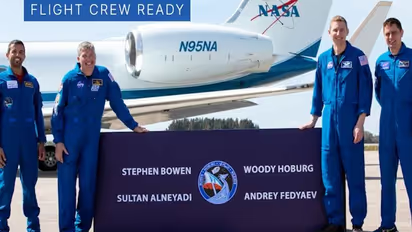NASA, SpaceX Crew-6 launch scrubbed minutes before launch; new date to be announced soon

Synopsis
SpaceX and NASA have called off an astronaut launch to the International Space Station after an issue with the rocket’s ground system was detected. With about two minutes left on the countdown clock, the launch was called off because of a problem related to the TEA-TEB ignition fluid.
In a major setback, the launch of NASA’s SpaceX Crew-6 mission from Kennedy Space Center’s Launch Complex 39A in Florida to the International Space Station has been scrubbed.
NASA astronauts Stephen Bowen and Warren “Woody” Hoburg, along with United Arab Emirates (UAE) astronaut Sultan Alneyadi and Russian space agency, Roscosmos, cosmonaut Andrey Fedyaev were going to the laboratory for a six-month mission to conduct scientific research.
The SpaceX Falcon 9 rocket and Crew Dragon capsule was slated to lift off from NASA’s Kennedy Space Center in Cape Canaveral, Florida, at 1:45 a.m. ET Monday. But the clock was stopped by engineers that oversee the ground systems with just about two and a half minutes left. The launch was called off because of a problem related to the TEA-TEB ignition fluid, which is used to ignite the SpaceX Falcon 9’s rocket engines at liftoff.
Also Read | Longest Arab space mission set to take off on the Dragon
According to Kate Tice, a systems engineer for SpaceX, in a remark on the livestream on Monday, the choice to cancel the launch was taken "out of an abundance of caution." The four astronauts are waiting for the rocket to run out of propellant before they can leave their Crew Dragon capsule, which was attached to the rocket in the hours before launch.
The next opportunity to attempt the launch is Tuesday, February 28 at 1:22 a.m. ET, though it’s not yet clear if the issue will be resolved in time. Additional back-up launch opportunities are available beginning on March 2, official said.
This mission is expected to mark the seventh astronaut flight SpaceX has carried out on NASA’s behalf since 2020. The four astronauts are expected to spend up to six months on board the orbiting laboratory, carrying out science experiments and maintaining the two-decade-old station.
Also Read | NASA to collaborate with DARPA to test nuclear-powered spacecraft by 2027